#but genuinely brainstorming and plotting and the whole creative process if you will
Explore tagged Tumblr posts
Text
i know my perpetual state of being always seems to be either joking or tired (lol) but one thing i can always make time for plotting - i might take a bit to open up but i do love just the whole process of brainstorming and plotting and i love hearing someone else's ideas and being able to combine them together with my own - plus just having someone equally engaged and excited, someone who wants to plot - it's just everything.
#( ooc. )#yeah i know i seem to be non serious here more often than not lol#but genuinely brainstorming and plotting and the whole creative process if you will#is what i got into rp for#it's what i joined tumblr for
4 notes
·
View notes
Note
For the ask a fic writer game-- 3, 55, and 61 (or whichever of those you like most)?
3. Describe the creative process of writing a chapter/fic
I'm gonna be honest, it involves a lot of lying on my bed and staring at the ceiling.
I don't make outlines, usually. Sometimes I will write up a little blurb ahead of time about what a chapter will contain, but that's it. Most of a chapter is written in my head, and then transcribed to my computer (I have to write on a computer, I can't do phones) so a lot of it is brainstormed when my brain is free but my hands are busy. A good chunk of the sea goddess fics were thought up in the car.
55. Of the characters you write for, which is your favorite? Has that choice been swayed at all by your followers/readers’ reactions to certain ones?
My favorite characters to write are the ones where I can get inside their head. Law is the obvious front-runner for this--I call him the Plot Tribble for a reason, he's the character that keeps on giving--but Robin, Sanji, Rosinante? All of them are super fun to examine, with all their history and hangups. Luffy is far and away the hardest to write for me, because he's the opposite of that, but it is super satisfying when you feel like you've gotten him right. Every character is different.
I wouldn't say any specific reaction has swayed those opinions. I write the characters that the story calls for in the moment. Though I will never be sad when people get excited over the way I approach writing them. That always feels nice.
61. Why do you continue writing fics?
Because I love to write! I've been writing my whole life; I'm pretty sure we've got some four-year old Rev scrawls still kicking around somewhere. But it's only relatively recently in the grand scheme of things that I've been willing to share things that I've written.
Like, I genuinely cannot stress how close I came to never pushing post on Code Switch, which was my first fic. Up until that point I had always been terribly embarrassed by my writing, despite the fact that I had been writing consistently. It was a weird place to be in, loving the craft and still not thinking my work was good enough to share.
Breaking into fanfiction helped me get over those fears, and I continue to write both because I genuinely enjoy the stories I'm telling, and because it keeps me engaged. And if (more like when, I know myself) get around to formulating a cohesive idea for original stories again, I will be far less out of practice and more prepared to give it a go than I would have been otherwise.
6 notes
·
View notes
Text
Steam Nextfest / 3 days in!
PLAYED GAMES
Town to City ; highly recommend even if youre not a fan of the genre, spent 4 hours with it. city builder that mechanically rewards you for decorating, and while the limited items in the demo means everything will look pretty similar, you can see theres more being saved for the full release which makes it a non-issue. if dont enjoy naturalist aesthetics it may not be for you.
Date Everything! ; if you enjoy the dating genre or a voice actor you really like voices one of the objects (yes they are ALL voiced), you will enjoy this. the writing is cute. most issues are technical ones- like the camera sensitivity being low even at the highest setting, the 3d environment Feeling unrendered (i think they could do more stylization with the textures and solve this), and not being able to open doors or toggle lightswitches while your glasses are on. im also not sure why you can jiggle objects or why theres a whole plot set-up with you having a remote job, but presumably that will be more relevant later?
Dispatch ; recommend even just for the animation, its a quick 20 minute demo. im not a superhero person but the banter with your team once you get into the gameplay is fantastic. the writers/directors from the wolf among us worked on this so if you liked that game you may like this.
Gecko Gods ; if you like platformers on the simpler side you might like this. underwhelming for me. ive had this game on my wishlist since 2023 since i think games where you play as a small thing in a big world have a lot of potential, but at least with whats playable in the demo, your scale doesnt change much of how it feels to interact and the biggest thing that relates to you being a gecko is your ability to climb on surfaces. you can eat bugs which is cool. i think they go into a collection. and yes the gecko is cute and theres a button to make gecko sounds.
Inkshade ; im sure it wont mind the comparison but essentially what if you took the first chapter of 'Inscryption' and made it the whole game. its fun even though in the demo theres not much to do in the overworld.
Nanamon ; tamogatchi-esque desktop idler. im not a fan of idle games so this ones not for me, but i did finish the demo and enjoyed what was there. the pixel art is adorable and smooth, and the few creature designs i saw were creative. if you like the genre or like the idea of having a pet in the corner of your desktop, you should try it.
After Inc Revival; do not recommend. i played the 3 story missions available, i think each was supposed to give a taste of different goals but they all played basically the same and none of the challenges changed my approach because theres so few actions you Can take. the game was designed and i believe is already out for mobile devices, so correct me if im wrong but it just doesnt seem like theres a lot to do here. oh also, they had a generative AI disclaimer on the storepage that they later removed once people got angry about their usage. their disclaimer said "Help create basic tiling environmental textures" & "Help brainstorm concepts and layouts for images (using our own sketches as a starting point)" so instead of removing generative AI from the process they just decided to hide it from new players.
INTERESTING BUT-PLAYED-VERY-LITTLE-OF GAMES
Troleu ; cool concept but repetitive mouse and camera movements put physical strain on my wrist.
Stario ; cool concept but camera was too difficult to control
Schedule 1 ; uninteresting concept but genuinely impressive town design and gameplay loop, would be more fun with friends!
Inkression; cool concept but technical issues made it unplayable for me.
Escape from Duckov ; uninteresting design (yes im a bird person but i have an instinctive aversion to "cute animals doing violent/serious things" because it feels cheap. cheep cheep.). camera movement felt "sticky" and hard to control, was also too zoomed out.
3 notes
·
View notes
Text
roscoe’s notebook post
A while back I said I was going to write a post about the way I use notebooks for writing projects. This is the first of several posts about Writing Process I’ve been tossing around in my drafts for a little while as a result of conversations with friends, so bear with me.
I. Love. Notebooks. I genuinely would have to deeply overhaul my whole Process of writing anything on the longer side if I were to go paperless; I find physical paper pretty invaluable when I’m outlining, brainstorming, and researching, and I still probably write ¼-⅓ of all my actual content on paper first. (That proportion used to be a lot higher, but I’ve gotten better at being productive on a computer in recent years, which is great.) I’m a very visual person, so notebooks really help me visualize my ideas, story structure, etc. It’s very helpful to be able to use arrows and diagrams and physically strike things through, and the tactility is really soothing to me. If I show people my notebooks or talk about them, I often get a response like “this is so organized”, which is sort of true, but I have to stress that it’s “organization for a disorganized mind”; I can’t misplace ideas or notes if it all goes into the same physical object, vs. electronic notes, which are much more, like “Did I say that in a voice memo? PM it to myself on Discord? Leave it in a desktop sticky note? Write it directly into the Google Doc? Who knows! It’s lost to time!”. It’s very much an ADHD management strategy.
It helps that I’m a very neophyte stationery hobbyist and appreciate any excuse I have to use my pens, but I also will go off at any opportunity about how helpful I find them for writing projects, which is why I decided to just make a post about it. Right now I mostly use them for (fan and original) fiction projects, but I used a notebook for a very similar purpose when I was working on my undergrad thesis, and I have a slightly different but equally necessary-to-me approach to notebooks I use at work.
My typical structure for a notebook that’s devoted to one project only looks like this:
I always leave the first couple pages blank so I can go back and retroactively index bujo-style. I don’t always actually do the index, because sometimes I get too lazy, but I like having those blank pages there to give me the option. I also usually put epigraphs/inspo quotes on the first page.
After that, there’s often (but not always, I’ll talk about it) a couple pages at the start where I’m frantically jotting down loose brainstorming ideas before they've coagulated into a story structure. Just, like, vomiting into the void.
Stemming out of that, I usually write out about like 5-10 pages of outline-style notes in chronological order, laying out all the main story beats and charting out the story trajectory. This will inevitably get revised and rewritten many times, but I find the process of writing these wide-angle synopses really useful for dislodging ideas, making connections re: thematic threads, etc. from my brain.
I’ll devote a couple pages after that to specific things like "sex scene brainstorming", "random scene ideas/minor details that don't have a clear place in the outline right now but I'll turn to for inspo later" [this is what I refer to as “bits” in one of the later photos], "page where I just outline the Motifs And Themes", "research notes", "to-do list", "stuff to check on a second pass", "things to put in the a/n and AO3 tags", etc.--the specifics vary with the story.
Then, I skip ahead to approx. halfway through the notebook and cordon off the rest of the pages to be “free writing” space, AKA writing of actual content rather than planning, with the expectation there will be no internal organization and I’ll transcribe to laptop as I go. Writing on paper feels less binding than typing something on a computer; it’s like a little secret kept with myself, and it doesn’t need to go anywhere or be seen by anyone if I decide I don’t like it. Setting aside pages in the back half of the notebook means that, as more things come up re: planning, I can go back and add those in the rest of the pages that were intentionally left blank. This is how I avoid (for the most part) having the whole thing be a jumbled mess where there’s no separation between the notes and the actual story writing; I learned this the hard way via the first notebook I’ll show you in a second. I’ve recently gotten really into using Muji sticky note tabs to label any pages/sections of particular import that don't want to have to refer back to in the index and would rather just flip to instantly.
I do use notebooks that aren’t specific to any one project, but those are much less organized and less worth sharing.
Before I look at more recent stuff, here are some selections from my notebook for the project that got me into writing longfic, my Golden Kamuy canon divergence AU (with apologies for the bad photos, my phone’s camera is trash). I worked on this from Sept 2018-July 2019. It was a learning experience in a lot of ways, and notebook utilization was one of those. I’ve always used notebooks for keeping track of writing projects, as I said earlier, but before this it was largely without much organization or structure; just total chaos. Having a physical notebook became really important for this project because it was a sprawling multichapter story with rotating POVs and a lot of historical research. I also learned a lot about what not to do with a notebook, personally, or at least things that don’t work so well (for me). This was a college ruled spiral-bound Decomposition Book, for the record.
By the time I bought a notebook for it I already had a (very basic) plot outline in mind, so I wasn’t doing that very initial ground-zero brainstorming in here; I was copying out of my phone’s notes app, basically, and then going from there.
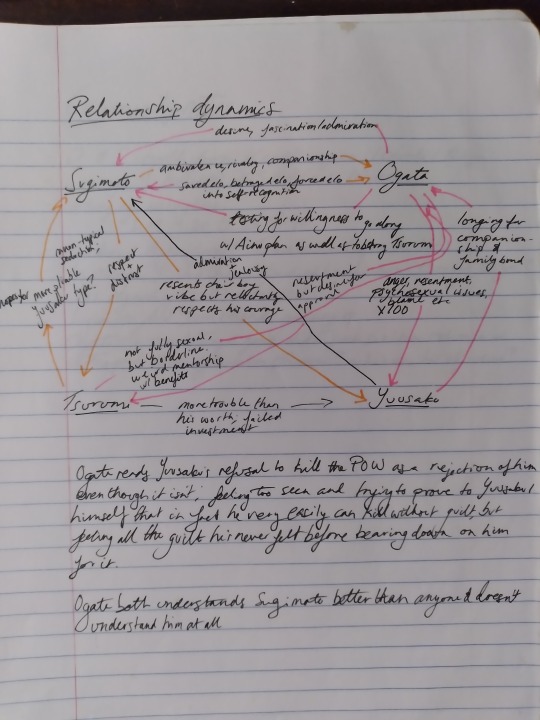
This is one of the first pages in this notebook; I wanted to visualize the relationship web between the four central characters in the story in terms of how they feel about one another. The two colours correspond to the POV characters (Sugimoto in orange, Ogata in pink), and I used this colour-coding throughout the notebook with highlighters, etc. to keep track of information that was more relevant to one character than the other. Tsurumi and Yuusaku aren’t POV characters, but they’re prominent in the story and their presence impacts the central relationship between Sugimoto and Ogata, and it was helpful to me to map out the emotional ecosystem, as it were.
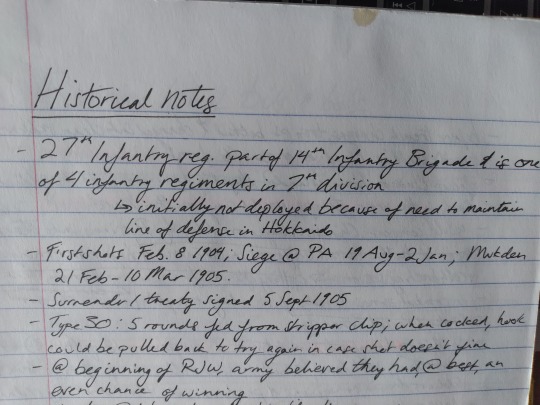
(There are coffee stains all over this, because I wrote the vast majority of the story in coffee shops because I didn’t want to be around my roommates, lol. This is part of why I never do fiction writing in notebooks that are too nice, I get neurotic about needing to keep them tidy. I can’t use ones that are too shit though, either, so it’s a bit of a narrow window. I’ll talk more about brands and paper quality etc. later.)
As you can see, this is the first page of many I set aside specifically for jotting down different pieces of historical information relevant to my story. It’s about fictional characters who are members of an army division that existed in real life, and both the canon and my fic involve a high level of attention to detail with regards to which divisions were present for which battles, etc., as well as general historical details specific to the Russo-Japanese War setting--what did people eat in the trenches? What did they do to fill time? How did they get through the winter? What did third party observers have to say about the conditions? What were the specs of their weaponry (particularly important because one of the POV characters is a sniper and gun nut)? I did a lot of reading (and watching of antique gun collector Youtube videos... the things I do for love, eh), and it came in handy so many times, because it turns out it’s much easier to write trench warfare slice of life if you have factual details to pull from when you don’t know what to do with a scene! Imagine that!
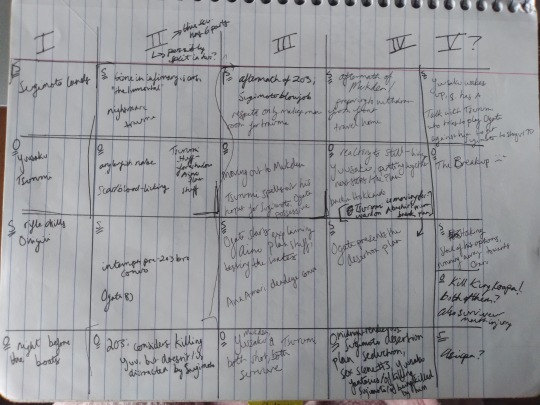
This is the first of three “grid outlines” I made; this is a way I sometimes like to visualize a story outline all on one page, with the columns representing chapters and the squares within the columns representing sections/scenes within the chapters. As you can see, early on I was hoping to get this done in five or even FOUR chapters (whatmakesyouhaha.mp3), with POV switches happening internally within the chapters. This proved to be unwieldy for many reasons, so I revised the outline:
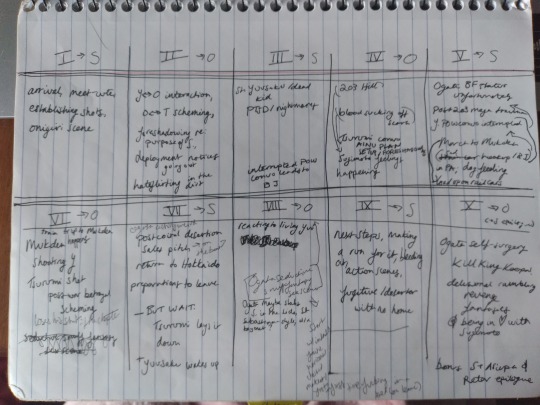
Here I’d come to terms with the fact this story was going to have a lot more chapters than I’d planned, and I rearranged things so that it would happen in ten, with each chapter belonging to only one POV character. This also needed revising later, and in the end the story looked a bit more like this (though it did in fact end up being twelve chapters, but only because Chapter Ten was like, 12k, and needed to be split in two chunks):
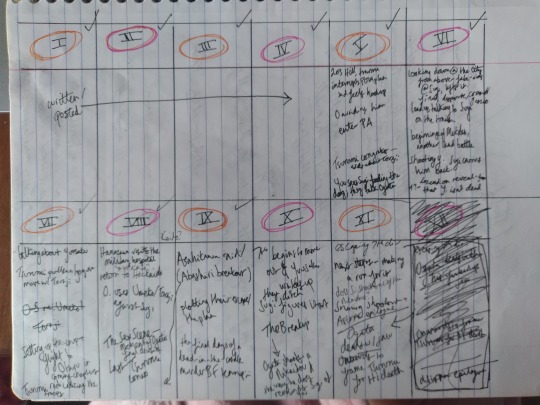
I must have remembered to bring my fineliners to the coffee shop this time, lol, because as you can see it’s properly colour-coded this time. This outline was made when I was already four posted chapters into the fic, which hopefully gives you a sense of the way in which I am sort of a planner and a pantser; I can’t get into a longer project without an outline, but the outline inevitably changes many times throughout writing and I often end up with a finished product that looks pretty different from what I was intending. My creative M.O. as always is Do The Maximum! Amount! Of! Work! Possible!
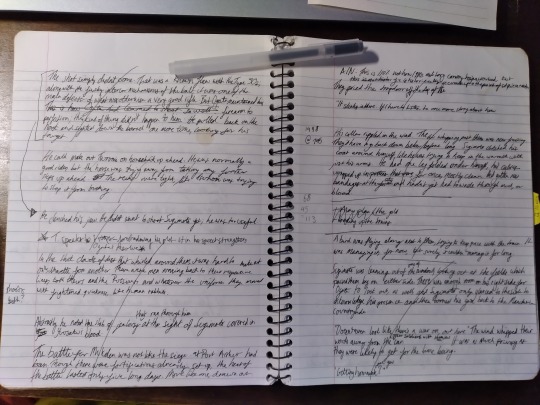
This is what a “free writing” page looks like, for me. In this notebook I didn’t set aside any specific spaces for free writing so it’s strewn throughout the notebook in a really disorganized way and I was constantly flipping through looking for bits I’d written and forgotten to transcribe, and I decided to be more organized in future as a result of that. If something’s crossed through, that means I transcribed it. As you can see, they’re often small sections, sometimes just a coupled decontextualized sentences. About 3/4 of what I write in a notebook makes it into the story, I’d say; some of it never goes anywhere, and that’s OK. I have less of an issue killing my darlings if they never make it off the paper page.
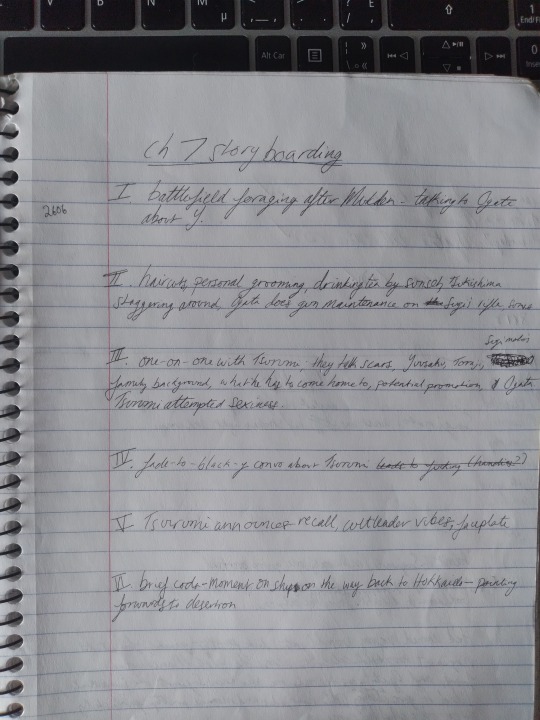
A very brief, top-down chapter outline, where the goal was not to get too bogged down in details and just to visualize the beats and pin down what they’re trying to accomplish. Chapters for this fic typically ran about 6k, and five or six scenes per chapter was pretty common, so the average scene length was about 1-1.25k words/scene. IDK why I called it storyboarding when I didn’t make drawings. (Margin numbers are to keep track of word count, since I was using a daily word count tracker while writing this.)
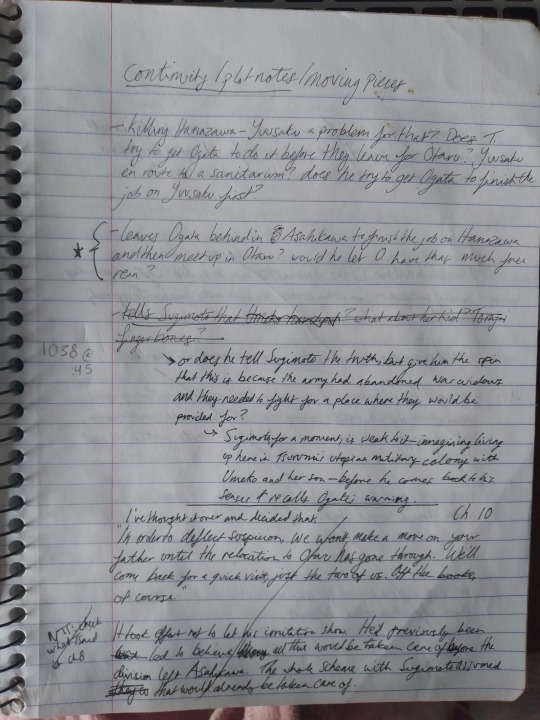
This page was, as titled, for keeping track of the various balls in the air when I was about 2/3-3/4 of the way through the story and really feeling the pressure with regards to tying up the various loose ends. This was... a struggle. I hadn’t ever written anything longish (this fic ended up just under 70k) that had an action plot before, let alone a canon divergence scenario where I had to engage with and explain away various canon plot elements so I could maintain the audience’s suspension of disbelief.
Now, I mentioned earlier that I learned various “things not to do” with my notebooks while working on that project. One of those lessons I learned is to be more realistic when assessing how big a project is likely to get, not least because I RAN OUT OF PAGES around the chapter 9-10 mark. In my defense though, that’s because I’d never written anything even half this long! But I know better now, and try not to be in denial. Finishing the notebook early was a way bigger problem than I’d anticipated, and was part of the reason the last few chapters took several grueling months to finish. The issue was that I needed to be able to use a notebook to maintain my workflow--attempting to do it only on a computer was dismal--but it seemed silly to start a notebook of a similar size to the one I’d finished (80pg, approximately B5 dimensions) when there was no way it would need that much space, especially since the reference pages, like the historical notes, didn’t need to be transcribed over. I was also pretty broke at the time and didn’t want to spend money unnecessarily, lol. I tried to get by using a Moleskine Cahier for a month or so because I had one lying around, but it was horrid; it was too small to be used comfortably, it wasn’t spiral-bound so it wouldn’t lay flat, the ghosting is terrible and I hate the way Moleskine paper feels, etc. Eventually I caved and went to Muji and bought a 30ish page A5 with closer to lay-flat binding, and I finished the story in there. I would take a comparative pic for you of the relative notebook sizes and include some of the scene staging diagrams, etc. I put in there, but I can’t find it :(
So I learned that specs really do matter, and it’s okay to be picky if the pickiness is going to make the difference between actually using a notebook or not. Things that are important to me in my notebooks:
Ruling (gotta have ruling, I can suffer through grid but blank or dot is a no-go)
Size (I can’t use anything smaller than at least a medium-large notebook, I find it claustrophobic and get miserly about page space)
Binding (twin ring is my preference because it looks and feels better than a classic spiral but has the same comfort of use with regards to bending the pages back to suit workspace size and laying flat with ease)
Paper quality and colour (I don’t like anything too slippery/smooth or with too much visible ghosting, and I strongly prefer an off-white paper to bleached paper--part of why I don’t use Decomposition Books anymore, the paper is scratchy and it’s too damn bleached!)
Pagecount relative to size of project
Portability (in non-COVID times; anything bigger than a B5 wouldn’t fit in the satchel I used to bring to work at my old job), etc.
But everyone’s taste is different in this respect, and the only way to figure out what works for you is through trial and error, I’m afraid. I also suspect I’m more neurotic and particular about the sensory experience of using a notebook than most people are, but I yam what I yam.
Now to talk about the notebooks for my current projects, where I’ve refined my approach somewhat. I’ve included less photos for these because they’re ongoing WIPs I don’t want to spoil completely, but I’ve tried to include some outline-type stuff to give you an idea.
My big bang fic is in the very ugly twin ring notebook on the right; I got it at a dollar store by my house because I needed something to work in and didn’t want to wait for an online order, but it’s been very serviceable for my needs. The paper isn’t even bad. The bigger notebook (B5) is my Sangcheng fic.
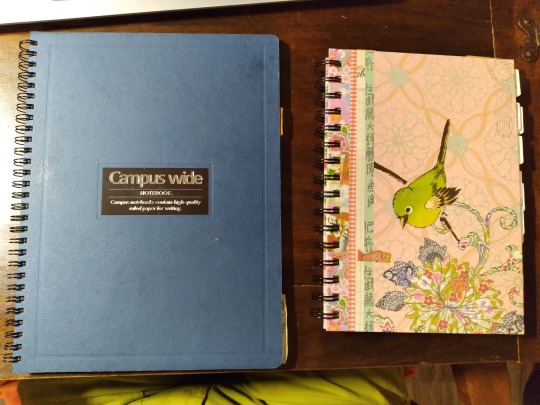
I wanted something with a lot of pages for this, because I knew it was going to be a long story, and for some reason the fact it’s smaller than my usual preference doesn’t bug me (I think it’s an A5?); it just fits this story, somehow. I’m not sure exactly how many sheets are in here but I’d guess about 150.
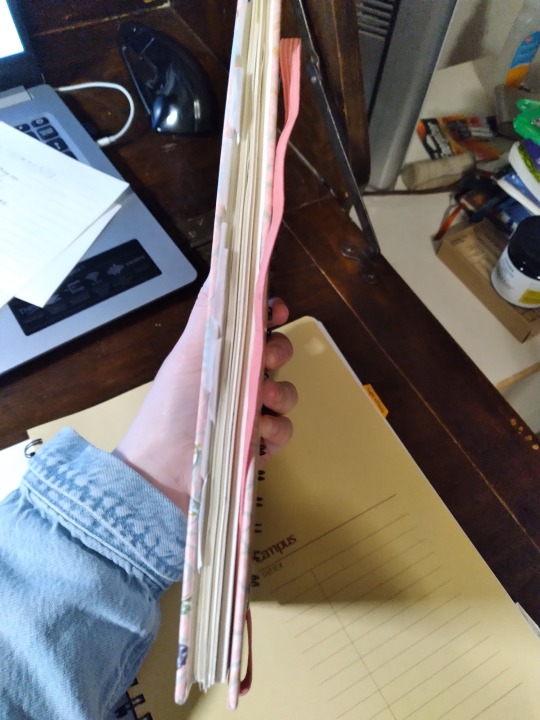
Because this notebook has upwards of 100 sheets, I made a lot of use of sticky-note tabs to label high-priority pages. The colour coding of these doesn’t mean anything, it was just whichever ones I had at hand at any given moment. These are those tabs from Muji I mentioned, I’m really obsessed with them--the shape makes them so much less obtrusive and more practical than conventional squares/rectangles OR flag shapes, IME.
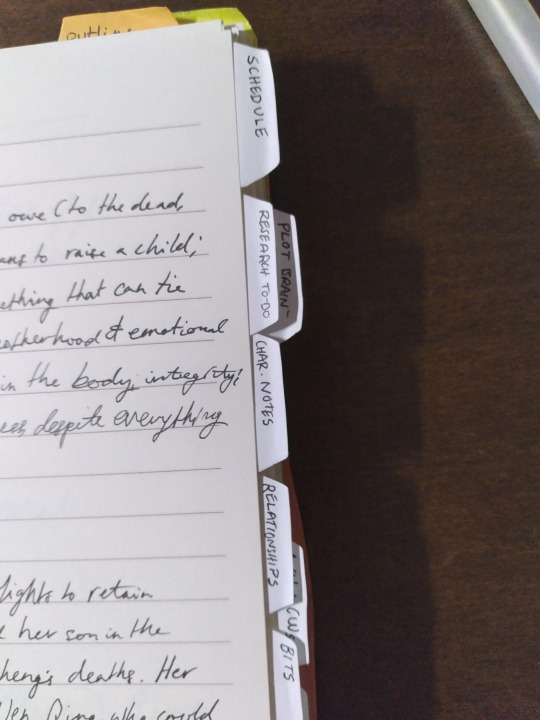
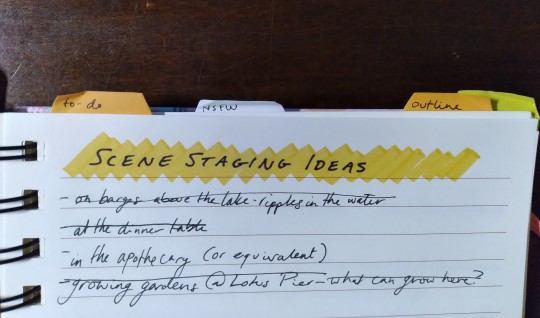
My big bang story is nonlinear, so, similarly to what I did with colour coding for the two POVs for my GK fic, this story has two main colours corresponding to whether a given section takes place in the “before” or the “after” portions of the timeline, with blue as “after”, yellow as “before”. This is what the most current version of the outline looks like in there:
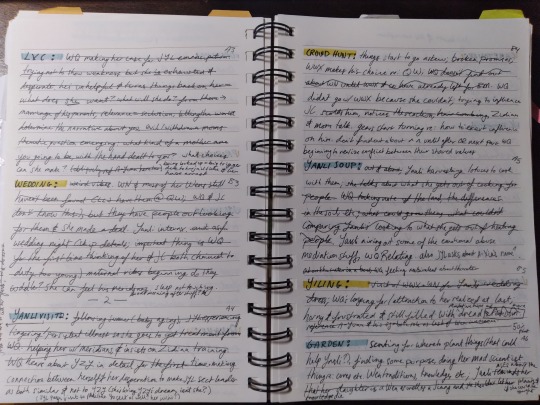
If you squint, you can see the alphanumeric notes in the top right of each section entry; I gave them each a code like “A3�� or “B5″ corresponding to their position in the story sequence (so, it goes A1, B1, A2, B2, etc., through to B9 and then the epilogue). [Unintentional that this schema overlaps with notebook size labeling and so is kind of confusing in the context of this post.] At first I was just keeping track of the sections via the highlighted titles, but it got confusing because I’d write down “Wedding” or “Yiling” in my notes and then refer to the notes later like “but there are multiple marriages?? and multiple scenes in Yiling??”. Stuff gets struck through with a straight line if it’s been written in a more-or-less complete form and crossed out with a squiggly line if it’s been cut from the outline or made redundant.
As I said earlier, I started out all the initial brainstorming for my Sangcheng fic in its notebook, instead of brainstorming it in someone’s DMs/my notes app/a voice memo/etc. and then transcribing it into the notebook in a somewhat more organized fashion, which is how my stories usually start out. Because of this, the first five-ish pages are basically just stream of consciousness rambling where I was trying to jot down every disconnected thought I had about the story concept. I don’t have photos for that because it’s too spoilerific for later developments in the fic, but I can show you some of the stages the outlines went through, once I was able to corral those initial notes into a story structure:
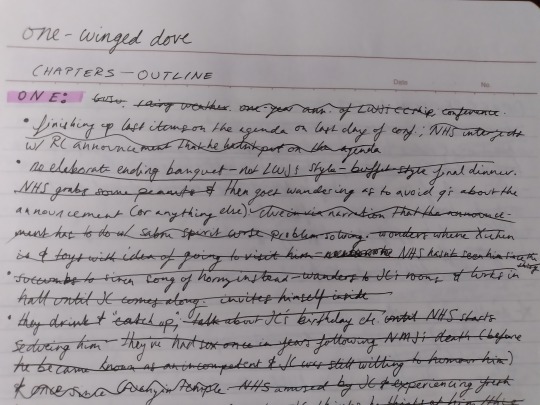
All the chapters in this fic have their own highlighter colour, so when I started trying to make sense of my initial brainstorm notes I just went through and highlighted stuff in the colour of the chapter it would make the most sense for, and then transcribed things more-or-less in chronological order into the relevant chapter outline. I later ended up rewriting all the chapter outlines AGAIN to refine them and divide them internally by the individual scenes, which makes them a lot more legible and less wall-of-text-y. They look like this now, with about four sheets per chapter:
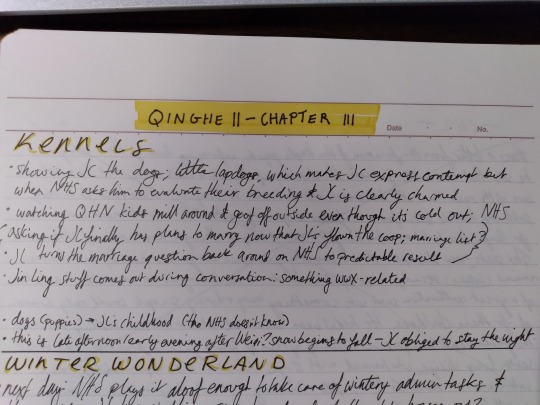
Because this fic is on the longer side, I have some pages that are just for keeping track of other story elements, like this, where I refer back to whatever the fuck the “themes” are supposed to be whenever I forget what this fic is about:
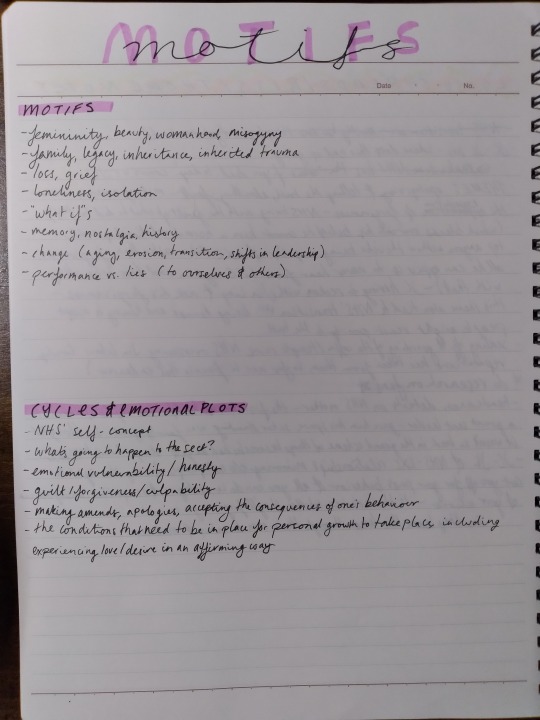
It’s all about the visionboarding... Anyway, that’s most of what I have to offer, since most of these two notebooks is Forbidden Content.
With regards to brands/supplies, I really like this Kokuyo Campus Wide notebook that I’m writing Sangcheng in, it’s pretty perfect for me. I also like the B5 Muji twin rings, but those only come in 30 sheets, so I wouldn’t use it for anything above a ~20k project. The B5 Maruman Spiral Note 6.5mm ruled/80 sheet is another good one, though I wish it was twin ring instead of spiral. As you can tell, I like Japanese stationery brands because it’s easier to find decent paper quality and minimalist design without shelling out $$ than it is with American/European brands, at least IME. I like Rollbahns too. But honestly, I can usually find pretty serviceable random notebooks that aren’t brand-name from Asian dollar stores; it’s really not something where you need to shell out tons of money.
29 notes
·
View notes
Text
So I recently did an AMA over on the Fair Game Effect discord server, and it was a whole mess of fun! I loved being able to get the chance to chat about the creative process that goes on behind the scenes, so I wanted to be able to share the answers with the rest of you ♥
I do tend to get kind of wordy for some of these answers, so to save your dash, find out a bit more about my writing process under the cut!
Keep in mind that there are mild SPOILERS up to the latest chapter of And The Reason Comes, if you haven’t caught up!
Question: I absolutely love the cadence of your writing, especially the slow way you unravel emotions. Was there something particular about the relationship between Qrow and Clover that you felt lends itself to this style of writing? Can you talk a bit about how you decide which emotional bits get more attention, and how you decide the depth to which you describe those emotions? That’s 2 questions, sorry.
Cart: Thankyou so much!! The biggest part of writing these two really comes from the fact that they're both adults with a lot of stuff on their plates. They've had enough experience with life along the way to know a few things here and there. They don't tend to rush into things, unless it's a good fight, and there's a lot of mutual respect for space and trust and time, so it was all about expanding on what's already there. In canon, we were always shown that there was this soft sort of trust building up between the two of them, but it was never anything in great leaps and bounds.
Qrow's shown himself not to be the sort to blindly trust without reason, and how easily that can break, so going into Reason I always kinda knew it would be a slow drag of letting him work himself out around this new force in his life. Clover himself has shown that he's this quiet but gently reassuring presence in his life, and putting them together is like a match skirting the edge of kindling. They work so well together; they recognise there's something there, so it was just a matter of letting them fall into step over the course of the fic.
As for the second question, hoo man, that's kind of a mixed bag answer! It all really depends on the brainstorming process of what plot points I want to tackle, and in what order they fall onto the page. Sometimes it's also a matter of just letting the scene play out by letting the characters say what feels 'right' at the time (which can sometimes go INCREDIBLY against what I originally had planned). There was always going to be heavier scenes versus lighter ones, so it's a bit of a balancing act to know when to let them come up for air, or when to let them linger. Not just for them, but also for the audience.
That's... probably the biggest thing I keep in mind when writing the heavier emotional scenes. It's not just the characters going through it, but whoever's reading it, too.
As to the depth part, that's... something that depends on the rhythm of what's happening. If it's a scene of heavier realisation, sometimes shorter, punchier sentences help portray that (eg: Qrow's realisation of what home is to him in the latest chapter), but other times, it takes something meatier to help feel what they're feeling (eg: that first kiss and Qrow's subsequent reaction). It's that striking-a-balance feeling again, and finding what works best for the pacing of the scene, and it's something I always have fun writing.
Question: What parts of Reason do you enjoy the most so far?
Cart: can I just say i've adored writing the whole thing jkhdfk
Man, I... really don't know how to answer this one. I've enjoyed the entire process of the fic, because it's been such a fun ride of ups and downs. I adore writing these two together, so sometimes it's the little things that really tick all my boxes.
I do get a giant kick out of writing action scenes, so the sparring match and the canyon fight with the Nevermore were pure indulgence for me to go through. I love the tender, more simple moments, like the noodle shop, or any of the time spent with the girls. Getting to see them through some heavy emotional moments, like at the lookout, or at Clover's apartment. Being able to explore some characters and have fun with them along the way; I mean, writing Winter has been an absolute blast and I never thought she'd be as fun to write as she has been.
Honestly, though, it's just a treat to be able to write a scene where Qrow is genuinely happy, because it's something that's so very rarely shown, and being able to give that to him is just so good.
Question: What is your planning process like? Reason is such a big story, how much of it was planned at the start? Did you have all the major plot points decided then, or did some big ones strike you along the way?
Cart: Kind of fifty-fifty, actually! I had a few big story beats in mind before I started putting pen to paper, but a lot of smaller, in-between scenes generally fall into place somewhat organically along the way. There were always some things that I wanted to do from the outset, for example, the sparring match, the noodle shop, Clover's breakdown, and the Nevermore fight.
Along the way, ideas will pop out of the blue while I'm doing dishes or something, or if I've been stewing about how to connect certain points. Those usually get jotted down and shuffled or reworked depending on how the story is progressing. The usual process kinda looks like this:
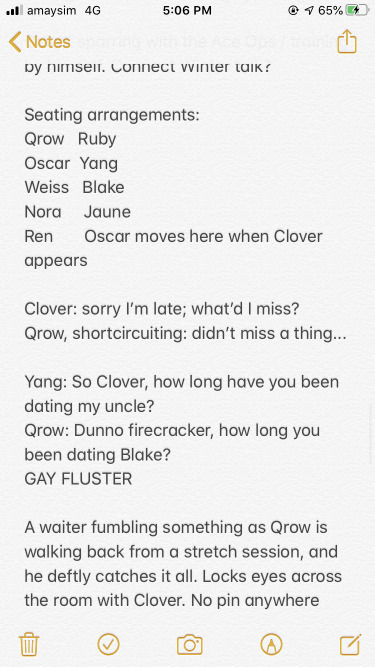
It's just quick little snatches of notes, but the actual scenes get WAY more fleshed out as the chapter plays out. Some things don't make the cut, depending on pacing, or if it doesn't fit the flow of where a scene goes, or if it's just going to pad out the story too much (as you can see from the last note there, it's something that never made the cut in the restaurant, but it was a fun idea to play with).
Question:
In addition to
Reason
, you also wrote a series of fics for Fair Game Week! How was writing those different than writing for something long-form like
Reason
? And which FGW was your favourite to write :)?
Cart: I actually get a real kick out of writing shorter prompts, because it really helps keep myself better in a character's head, ie seeing how they react to different situations, knowing how they'd respond to something, that sort of thing. It's a good mental break to be able to sink my teeth into something shorter, and with a concise ending, rather than a bigger, ongoing project like Reason.
As to a favourite, man, I adore Feint because getting to go over the parts and pieces of Harbinger was amazing, though I really do have a soft spot for Sinew because writing a sick floppy bird getting cared for by Clover was just fun.
Question: It’s so lovely to hear about how much you’ve enjoyed writing Reason from your answers! Have you gotten stuck on any part, and if so, how did you work through that?
Cart: Oof, I have gotten stuck quite a few times along the way. Wrapping up the restaurant scene was a big one, and definitely when Ruby, Clover and Qrow left the canyon to return to Mantle. There's an upcoming scene with Winter that I had to revisit quite a few times, because of certain subtleties in phrasings or how she was speaking very carefully with someone without either of them saying too much that would cross a line. I still find myself getting stuck with Ironwood, but mainly because I still haven't gotten his voice right in my head.
Working through them, to me, is just a matter of pushing ahead with a scene, letting characters talk to one another, or letting them get their own thoughts out, because sometimes in doing that, it helps me stumble across something that leads into another scene. Or having a goal to work towards - another scene - and just finding a different way to connect the two.
Question: What inspired you to begin writing Reason?
Cart: Honestly? It was seeing Qrow taking the first real, productive steps into healing, and finding himself working alongside this positive parallel of a person, and reacting so wonderfully to it. After Clover's introduction, it was clear that he was going to be such a healing presence to Qrow, and watching Qrow open himself up to this man little by little was something that was wonderful to see.
It was because of that I really wanted to do something with this healing process, and help the two of them connect in a more solid, in-depth manner. It's honestly why them becoming a couple took so long to come around; I wanted the focus to be on their trust and connection first, and their relationship as a couple to come afterwards.
Question: If you don’t mind me asking (feel free to ignore if this would be too spoilery!), but going forward with Reason, are you planning on including any canon scenes from the show?
Cart: It's something I've been tossing up for a while, pretty much ever since I started writing it, to be honest. It's why the fic takes place in that little handwaved time pocket between their arrival in Atlas and the elections, because it gave me enough time to play around with something if I did include canon scenes.
Going forward... I'm not too sure! If I did, then many things would certainly change, but at the current pace of things, and with the loose ending I have in mind, it might be hard to wrangle in. But hey, maybe we'll see!
Question: You navigate through a lot of different emotional beats in Reason so deftly!! Do you have any strategies you use to keep everyone in character as you write?
Cart: Thankyou! A couple of things I always try and keep in the back of my mind when writing: does this sound like something they would say in canon? And is this something that the audience is going to find enjoyable?
Obviously, the characters change a little over the course of the story, so subtle changes will be there, but for the most part, I always stick to those two loose rules when I'm putting pen to paper. As an aside, Reason wasn't actually my first foray into writing these characters! I wrote just a few simple, throwaway scenes and snatches of conversation, just to get a feel for them and their voices before I really started writing the bigger stuff.
23 notes
·
View notes
Text
twas tagged by both @parallelmarvel and @tare8chan. i actually cant believe i was hhaha i’m aiming to be the legit writer worthy of this tag game other writers participated in. think u for thanking of meh 🥺🥺🥺🥺🥺
Author Name: smellycinnamonthundahfudge on tumblr, AND JUST IN, I’M petertheparkerpus_mjmonogram ON AO3 YALLLSSSS. I FINALLY CAME THEEERREEE YYAAAYYYYY
Fandom You Write For: predominantly mcu’s spideychelle. (i also wrote tz stuff back then heh). but, i have also written (but not posted) for hiccstrid, got, darejones, simmosa, incredibles 2, and bughead hahaha.
Where You Post: i started on tumblr, so literally all of the works i wanted to share are on here. buuttt, like i said, I JUST GOT AN AO3 ACCOUNT YALLSSS. i’ve posted my first pj fics on there for now, but i havent posted em all yet so i am now beginning the process of importing em. im excited :’’’)))
Most Popular One-Shot: Take Flight (peter & mj’s flight home from the ffh trip, click for a nervous jelly peter hehehe)
Most Popular Multi-Chapter Story: hhmmm, ok, so i’m not even sure if it classifies as a multi-chapter haha but i think so cus i wrote them as a continuous story in mind haha. i posted the “chapters” separately but i like to imagine it was just one story, Safehouse Sleepovers (consists of Safehouse, Safehouse Singalongs, and Hot chocolate). it’s my only multi-chapter story (not even sure if it classifies as one haha) so de facto most popular one hahaha. oh and it’s essentially a canon compliant post ffh fic bout pj bonding in the parkers’ safehouse hehe. (oh but i guess maybe the newly named airports could also be considered multi-chapter, is 2 chaps enough to call it that? haha so dunno maybe i take back the only mc story thing haha. it’s still the more popular one tho cus airports i wrote before ffh even came out haha)
Favorite Story You Wrote: oof this is a hard one... ooohhh, i feeelll like i gotta, just gotta go with 5 + 1 gifts and Just Breathe cus they’re just so precious 🥺🥺🥺🥺🥺 but tbh i luv all of em. just as whole fics, they seem better to me haha
Story You Were Nervous to Post: ALL BRUHHH i mean im just not that confident with my works yet haha. buttt the one i was rlly the most nervous about was Home for the Holidays cus it was my first time writing with an actual person in mind to write it for haha. plus, it was the first fic i wrote after pj month so oof gods was i rusty by the time i wrote it hahaha haaysst. i think it was ok enough tho. plus they said it was good so yay. im just glad i actually did it haha.
How Do You Choose Your Titles: eh just whatevs i feel is catchy and is a good concise nice indicator of the plot heh. hhmm i feel like i usually come up with titles during the brainstorming process for the fic, like before actually writing it or while writing it.
How Many of Your Stories Are:
Complete: if im counting the “chapters” i mentioned earlier as one story each, then probs round 24. i say probs cus there’s some fics i wrote somewhere, where i feel like i finished em but i dont have access to them currently so im not 100 if it’s complete by my standards or nah haha
In-Progress: hhhhmmm im not sure if it’s write to call these in-progress. i’d rather call em unfinished, like i have 16 unfinished stories, or just written out story outlines. im not sure if i should call em in progress cus im not sure if i even still rlly plan to finish em, yknow? haha like they really are genuinely fun interesting n creative story ideas n plans thus far, i feel. but i just- lazy, yknow? haha i have to build up to writing a story for A LOONGG TIME haha
Coming Soon: hehehehe. technically it’s completed already, all i have to do is just make the post on tumblr hehe (as of the moment i wrote this post). im so excited for yalls to read The Bathroom hihihi <333
Upcoming Story You’re Most Excited to Write: oofff im not even sure if im actually gonna wind up writing these buuuut, dancing pj still seems so cute n pure n fun. and also, in addition to the countless other aus my annoying brain came up with on pj month, my brain annoyingly got even more fic ideas rolling around it now:
a moulin rouge au (peter’s the famous singer/dancer known as the spider-man who attracts men and women alike in the famous moulin rouge run by liz toomes with a gallery of other colorful rogues, heroes, villains, and just other sorts of attractive characters based on the comicbooks of old. mj is a young new budding writer looking to gain world experience to write about. she winds up in the moulin rouge, meets the infamous spider-man and gets to know the kind man behind the alluring and mysterious mask. im imagining tom’s lsb, laura’s hollywood, and z’s halloween euphoria ep costume for the aesthetic im going for haha. im still torn on whether to keep the og ending or not hahahaha)
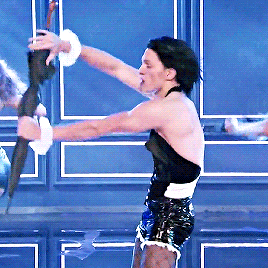
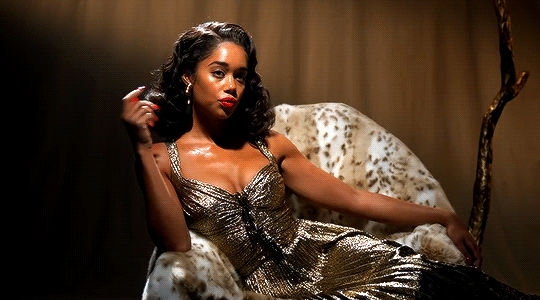

maybe a friends with benefits fic. where it’s not so angsty or full of drama. and genuinely just keeping it cool and chill til they inevitably just decide to actually get together/stay friends. it’s all up in the air and they’ll figure it out when they figure it out.
producers inspired, roommates au. the kdrama did the trope well and it made me want to see it applied to my two dorks 🥺🥺🥺🥺
lastly, a first time fic for our two dorky virgins hahaha. i kinda like the idea of them planning out their first time to the most minute of details and just the actual process of figuring out what they want to do n stuff haha just seems real cute to me 🤗🤗🤗🤗🤗
Do You Accept Prompts: hahahhaha look, i’m never one to say no ok? i mean, if i just straight up say no, im possibly saying no to potential ideas that are so inspiring i wind up writing it immediately. so yes, i’d like to say im willing to accept prompts. however, there is absolutely no guaranteed follow up and for that i’m sorry. i can just never know how i’ll react to an idea so there ya go. that’s my honest response haha.
im taggin the fic writers ive read over the years that havent been tagged by the ones that tagged me. hold my juice box. @spideymjlove @jediparkers @itsjacobperalta @thatsnicebutimmarried @bookishandbossy @thefudge @galaxy-parker @spideychelle-romanogers @spiders-n @petty-parker @smalltreenergy @dead-end-street @softboyholland @mamgt @justanotherfangirlpassingthrough @machiavelien @peterjonesparker @blaisezabini @thegreenwomanswalkman @crazy4dragons @dragonydreams @attachedtomybookshelf @haddocksortails @dyannehs @funkytoes @jenni41 @rebelcaptaindaily @starxdust22 no presh obvi. just thought dis might peak yalls interest. thanks for all that you’ve writtteeennnn 🥺🥺🥺🥺🥺🥺🥺🥺 🥺🥺🥺🥺 (btw some of yalls might have just written hcs for all i know, i literally dunno anymore, but like i said iz nbd. just also wanted to give my thanks since im not entirely sure i was able to do so before)
9 notes
·
View notes
Note
Hi! It's me again sorry I just love ur blog so much please don't slice my body in 26 pts.😂 Jk! qwq any Headcanons for La squadra with an Aspiring mangaka S/O? Like she really REALLY Love to make a comic so much? (Take note she's not sassy as Rohan lmao)
ur lucky none of my knives are sharp. (lmao jk jk I’m so happy you like my dumb blog aaaaa)
Risotto
Intrigued but hesitant. Hopefully you don’t plan on incorporating his likeness into your manga at all. He’d be antsy about a character inspired by him, even if it bore no resemblance to the real thing at all.
He has a habit of throwing himself into his own work, so he doesn’t often ask you to take breaks or remind you about things like food and sleep. More or less leaves you alone if he sees you’re really deep into your work.
Enjoys working on his own stuff in the same room as you. There’s something to be said about enjoying each other’s company in silence.
Really likes looking over your shoulder as you draw. He was never artistic so watching how rough sketches become inked panels is fascinating to him.
Gifts you fancy pens often, even if they aren’t the best practicality wise. He would be thankful if you gave him specific names and thicknesses you liked.
Prosciutto
He’s another one that doesn’t drag you out to take breaks, but unlike Risotto he’d at least bring you coffee. He’d like to sit with you too, instead of leaving you be.
If he sees you’re becoming exceptionally tired Prosciutto would kindly (and firmly) suggest that the two of you retire for the night.
If you ask him for his opinion on something he’ll be honest with you. Prosciutto doesn’t sugarcoat his words, but he does make sure to reiterate that he’s proud of your work no matter what.
Great at pep talks and surprisingly good at brainstorming ideas with you too if you find yourself stuck on how to advance the plot.
Of a similar mind to Risotto when it comes to ‘cameos’ in the manga. But if he sees a character wearing something that looks suspiciously like Grateful Dead’s eyes he’d be flattered.
Pesci
He’s a nice middle ground between Prosciutto and Fromaggio in terms of getting you to take a break. He’s not as annoying as Fromaggio is but more insistent than Prosciutto.
Pesci is already a fan of anime and manga. He’s read enough manga to know a bit about panel composition and the general process of writing one and if you ask he’d hesitantly offer up what he thinks are good suggestions.
He doesn’t want his opinions to get in the way with your creative process so he’d be hesitant about sharing unless you assured him you really wanted him to.
Would never ask you to draw him in your manga, or pester you for art but if you drew him in the background of a page he’d be incredibly flustered and happy.
If you get fustrated and throw away a page he’ll take it out of the trash and keep it.
Fromaggio
Please make him the star of your manga, he won’t stop pestering you about it.
Also please draw him in your style, he will pester you about that too.
Don’t tell him how the plot is going to go, he’ll spoil it somehow.
He gets antsy if you work for too long, especially if he’s just come back from a job and he hasn’t seen you in a while. He’s gone enough for his work anyway, why would he want to spend his limited free time in silence watching you draw when you two could be doing something fun?
Despite his habit of trying to pull you from your work, he’s actually very supportive of this. He’d help you mail off copies of your work to publishing companies and is the first to suggest a massive party when one of them inevitably offers to publish your work.
If he catches wind of people talking shit on line he can and will make a throwaway account and debate them.
Illuso
watching you work from the mirror world because he prefers to do everything from the mirror world. If you invite him in though, he won’t decline.
Not too familiar with the process of manga writing but enjoys watching it anyway. He’s pretty low maintenance so he doesn’t mind passing the time with only the sound of your pens and pencils breaking up the silence.
Takes note of the type of pens you like to use and what they’re primarily used for (shading, line work, blocking, detail, etc) and those will sometimes appear on your desk.
Likes listening to you talk about your work, the fire in your eyes is endearing to him.
He’s not an artist himself but if you ask him for an opinion on something he’ll give it to you no holds barred.
Never realized how much of a technical aspect there was to manga writing and finds himself fascinated by all the little things you might not notice when reading like text formatting and panel composition.
Melone
another one that wants to be in your manga
while he certainly has a preference for certain genre if you write something outside of his typical favorites he’d be happy to read it anyway.
spitballs character concepts and power ideas with you for funsies.
Enjoys hanging over your shoulders to watch you work even if it gets in the way.
Would 100% cosplay the main character of your manga and make it weird by hitting on you the whole time.
Would also make it weird by asking you to draw what you think your kid together would look like.
Genuinely treasures any art you give him though. He frames it and keeps it in a place he can see every day.
Would get misty eyed if you made a character inspired by his older sister and gave her a happy family.
Might want to write a children’s book with you one day. He’d supply the text while you drew the pictures. But he wouldn’t mention it until after you finished your manga. Doesn’t want to distract you from your primary focus.
Ghiaccio
He’s kind of like a built in editor which is either really great or awful depending on how well you take Ghiaccio level ‘critique’ because while he might love you, that doesn’t mean he’s going to go easy on you.
Ghiaccio is more a stickler for writing rather than the art or panel composition of your manga. If you’re going to let him read it while its still unfinished you’re going to have to be careful which idioms or turn of phrase you use.
He’s supportive though, and while it might not be possible to cut him off once he’s started picking apart an idiom you used that he took issue with at least he apologizes later about it.
One of the ones who makes sure you take a break weather you want to or not.
Enjoys the quiet moments together where you’re working on your manga and he’s reading in the same room and you two are just spending time together like that.
Surprise him one day with a ‘candid’ drawing of him reading with you and he’ll be a mess.
#risotto nero#prosciutto#pesci#melone#illuso#fromaggio#ghiaccio#jjba writing blog#jjba headcanons#vento aureo#jjba part 5#jojo kimyou na bouken#JoJo's Bizarre Adventure#la squadra#la squadra hcs#im not dead#just suffering because school#and back problems rip
42 notes
·
View notes
Text

𝚒'𝚍 𝚋𝚎 𝚠𝚊𝚛𝚢 𝚘𝚏 𝚝𝚑𝚎𝚖 , 𝚖𝚢 𝚏𝚛𝚒𝚎𝚗𝚍 ; that there is BENJAMIN GOLDMAN , notorious for being ( absent-minded ) and ( high-strung ) , but there are times when he can be ( scrappy ) and ( genuine ) . i’ve heard that he could pass as a JAKE BORELLI doppelganger , but i don’t see it . the ( twenty-nine ) year - old cis male ( witch ) has been in town for ( four days ) and they are a ( freelance photographer ) affiliated with ( no one ) . they tend to spark images of action figures fading on dark wood shelves, so well-worn that their painted faces are chipping away to blank masks behind , empty plastic cups from convenience store icees , and round glasses with fingerprints that won’t wipe away .
Hello, all, I’m Max, and this vaporwave disaster witch is Ben. I look forward to writing with you all! I’m a bit terrible at Discord, but will try my best to be actively present both there and here. Feel free to reach out to me anytime, and I’d love to come up with something together. Below the cut is a Sparknotes version, but a full bio is also here.
I. Basics
Name: Benjamin Goldman
Nicknames: Ben, Benny
Age: Twenty-nine
Gender: Cis Male
Pronouns: He/Him
Species: Witch
Nationality: American
Sexual Orientation: Homosexual
Romantic Orientation: Homoromantic
Education: BFA in Photography from The New School
Occupation: Freelance Photographer
Affiliation: No One
II. Stats
Positive Traits: Scrappy, Genuine, Determined
Negative Traits: Absent-minded, High-strung, Idiosyncratic
Height: 5′6″
Eyes: Brown
Hair: Brown
Zodiac: Capricorn
Religion: Jewish
MBTI: INFP-T
Aligment: Lawful Neutral
III. Background
Benjamin was raised by adoptive parents in a seaside tourist town. His biological mother was a human, who placed the boy up for adoption shortly after his birth. Ben’s father, unbeknownst to anyone, was a witch, and Benjamin inherited his magical bloodline. Those capabilities lay dormant within him for much of his life since he had no reason to believe in them.
He was a quiet, easily picked on child, often lost in fantasy: cartoons, comic books, and video games, particularly in the local arcades. Still, his upbringing was a good one with loving parents, despite the nagging feeling of a missing piece.
As a teenager, Ben started working at a boardwalk photo booth, taking ‘western’ and ‘gangster’ snapshots of a families on vacation. Earning his affinity for the camera, he eventually attended university in New York City and earned a degree in photography.
While he began by trying unsuccessfully to break into the art scene, he made his money on weddings before shifting to stock photography for advertisements and the like, which is where he retains consistent work today.
That said, he continues to hone his creative aspirations by night. His photographs are sad, lonely things, people sitting alone against artificial lights, perhaps revealing an internal discontent brewing within the artist.
He started the process, with his parents’ approval, of tracking down his biological family and was able to successfully reconnect with his birth mother. The two have started a tenuous budding relationship, and it was from her Ben was able to glean some information on his mysterious father.
That lead has brought him to Vermont, where he has just arrived with a first name and little else to go on. He’s pretending this whole thing is a vacation, but he may be getting more than he bargained for.
IV. Potential Plots
These are some vague, general, initial thoughts, but I am very open to brainstorming and more and having Ben help in your development of your own characters! Friends, enemies, frienemies are more are welcome.
The Mentor : Benjamin is unaware of the supernatural world and of his own dormant capabilities as a witch. This person could potentially guide him into it and help unlock that potential, or could potentially serve as an ally in discovering where exactly he comes from.
The Wrong Crowd: A potentially more sinister version of The Mentor, this person may willingly or unwillingly introduce Benjamin to the darker side of the supernatural world. A naive young witch with untapped abilities begging for release could easily be swayed by the promise of feeling powerful.
The Old Rivalry: Benjamin is a new face in town, but his father’s family finds its roots there. Perhaps there’s old local conflicts that he might find himself sucked into despite being unaware of them? Or perhaps he and someone else might bridge that conflict?
4 notes
·
View notes
Note
what is your writing process like? how long does it take you to develop the story-line and to actually sit down and write? i have some cute Namjoon fic ideas, but i don't want to start something and then fizzle out part way through....how do you maintain your motivation? ❤️the Ji to your Hope anon ❤️
This is going to be a really long answer, so I’m going to cut it with a “Keep Reading.” If you have any problem seeing the part below, please let me know and I can make other arrangements 😊
ALRIGHT. So first things first, I apologize in advance if I sound pretentious. At all. It’s definitely not my intention. The following comes from a place of my passion for writing and I hope that whatever meaning you derive from it can help in your own journey of literary exploration!
Now, as you probably know, I’m an English major working on an emphasis in creative writing. I’ve taken a few creative writing courses and have bumped elbows with a lot of brilliant writers. Below I will compile an answer based off of my experience in those classes mixed with my opinion. If you would like an elaboration on any part, please let me know and I will be more than happy to explain.
1) my writing process
Honestly? All of my life, I’ve kind of just started writing. This doesn’t seem like very helpful advice, so let me explain 😂 Once you find a source of inspiration, no matter how small or seemingly insignificant, don’t throw it away. You never know what kind of story it will blossom into. For example, it could be something as interesting as the night out that lead to my story “Deep Down, Inside” or something as simple as, say, frustration at how good a person looks when they’re a strawberry blond so gosh darn it now you’re writing a whole entire series about it and people seem to like it for whatever reason and what the HELL it’s now like the most popular thing on your blog- but yeah. Catalogue things that inspire you even if only in bullet points in a list on your phone 😄
STEP 2) after finding your inspiration. Start writing. It’s just that simple. You can always delete or edit an introduction later. If you’re interested in quick “getting started on a story” tips, just ask! And once you start writing, don’t stop. In the words of Ron Carlson, “don’t leave the room” literally or figuratively. You’ll want to look up names, definitions, get a cup of coffee, etc. DON’T DO IT! Those can be done later 😉 Often times our biggest weakness when it comes to writing is DISTRACTIONS. The more you leave, the less you’re writing. And the less time you spend writing, the harder it’ll be to remember your inventory (a word that will be elaborated upon later).
Now, this all stems from my belief that the writer should not force a narrative to go somewhere. Essentially, the author should have a conversation with their story, not guide or corral it. This allows for genuine character development and interesting, unexpected plot twists (ironic, I know, but you have to admit that in some stories, certain “plot twists” are completely expected). I will elaborate on this more momentarily.
Essentially, my writing process is: after finding something inspiring, I open up a document and start typing. Then keep typing. Don’t edit. You’re not there to be an editor. You’re there to write. Everything else comes later.
2) How long does it take me to develop the story line and to actually sit down and write?
Well... my life is kind of sad in such a way that I cannot live without writing. I go through literal withdrawals and depressions. I approach it like an art, like a part of myself. It may sound dramatic and it totally is, but words just burn me until they get out of my head. So it’s relatively, ridiculously easy in a way that’s really unfair when I’m giving advice for me to have ideas. It’s almost a detriment 😅 To answer the question directly, personally, I have two approaches to planning a story line.
1) I have no idea what the heck I’m doing and I write only what the story seems to want (see Goldilocks). This allows for more genuine characters as I let them speak instead of me speaking for them. Their dialogue, in my mind, becomes the words of a real person with real dreams and real aspirations and real motives (yes, I say this word addressing its negative connotations too). This option also makes writing a lot more fun for you as the author! 😄 why? Because every surprise for the reader is also a surprise for you~
2) The second option, my only other approach because I am a pendulum person, is elaborately planning out the plot (see Without You: Bloodstone). This can often be exhausting and intricate, obviously taking a lot of time and effort on your part to make sure every little detail matters. I do not recommend this for people who want to write casually/sensationally/shallowly for lack of better word. I’m not saying that these are any worse or less nor greater or better than deep, rhetorical writing 😊 it’s like different tastes in foods~ we each lean a certain way and it’s good to dabble in the other style every so often but let’s not kill ourselves over it, yeah?? (sensational vs. rhetorical readers/writers- a term I came up with- is a whole different conversation). ANYWAY! Bloodstone, as my primary example, took me a week in total to brainstorm. At least... the general lore stuff. The plot itself mostly stays true to my “making it up as I go along” motto, just with a few set plot points as guides. Essentially, I build the world my characters live in, give them a problem to solve, and then let them solve it on their own terms instead of mine.
Hopefully that makes sense? 😂 obviously, these are not the only two approaches and they are on a spectrum. I highly recom”mend you find a place on it that’s comfortable for you 💖
3) how do I maintain motivation?
Again, writing to me is an art. It’s something that I have to do in order to be a happy, functioning human being. So my answer might be a little unfair... and I apologize for that. I’ll thus try to approach the question objectively.
First, I’ll pull back what I said earlier, “Essentially, the author should have a conversation with their story, not guide or corral it...This option also makes writing a lot more fun for you as the author! 😄 why? Because every surprise for the reader is also a surprise for you~”
If you’re having fun while writing, it’s a lot easier to keep writing, no? If you know exactly what’s going on at all times, it gets boring. If it’s already panned out in your imagination, why write it at all? To get notes? I will always be an advocate of “write for yourself first and foremost.” This also makes the story more enjoyable for you.
Second, I’m going to address the dreaded writer’s block. A lot of people will say “set the story aside and come back to it later.” To that, I retort with, “No don’t you dare do that because you and I both know you’ll probably never pick it up again.” STAY IN THE ROOM (to quote Ron Carlson). I believe that one of the biggest causes of writer’s block is not knowing where to go. This is a fair observation, yes? Your brain basically says “yup. This story has reached a dead end” and “dead end” translates to “conclusion,” a rather frustrating imaginary/subconscious “the end” even if you feel like you still have more plot points to reach.
But Kay, what do I do to get myself out of this?
If you want to save your story, it’s time to do some editing! Well, okay, maybe not editing, but rereading. You need to take an inventory. Key word, remember it. INVENTORY. This is a literal list of physical objects, characters, and plot points/loose ends. If you write on the fly, there will sometimes be items that appear. You’ll have no idea why they’re there. A lanyard, a book, something as random as a spatula? Sure. If it appears in your story it might be useful later. These are physical objects that your brain can attach to and can move around in your story’s world. Maybe that lanyard thrown so haphazardly into a physical description of the love interest’s backpack becomes a telltale sign that it was them that left that anonymous love letter in your protagonist’s desk because it’s now wrapped up inside. Maybe that book you mentioned when describing the setting turns out to belong to your protagonist’s grandfather and helps them figure out the mysterious anagram that had been left in a dusty diary found in the attic. Maybe that spatula so casually used to make brownies during an interview turns out to be the murder weapon. YOU NEVER KNOW.
I’m going to lump characters and plot points/loose ends together simply because I feel like this is getting hella long (whoops). Personally, I’ve learned how to notice loose ends while I’m writing and will keep a bulleted list of questions or things to be resolved at the end of the document so that I can see it while I’m writing. This lengthy list will often have character names and important traits/facts as well (example: did you mention an age? a day of the week? a season? Did your character ever text back that one dude?). And if you feel like you’re missing something or running low, go back and reread. Your inventory can always increase.
This list will be a lifeline when stuck with writer’s block. You need to resolve SOME of these issues that are now (thank GOODNESS) explicitly listed right in front of you. Even if it doesn’t feel like you’re moving along to your next planned plot point, who cares? 😄 Maybe your story doesn’t want to go there!
And in the end, it is my belief that your story will sound more genuine, more real if you let it speak to you.
I hope this helped! And I look forward to being able to see your fic 😊 keep me posted on how it’s going and if you need any help brainstorming or just want to discuss creative writing in general, I am always down for that.
Much love ~🐰 xx
4 notes
·
View notes
Text
youtube
Silent Echoes (2011)
A young teenage girl finds herself trapped in an unknown location. As her captors torture her for information, Amber, being deaf, faces the challenge of escaping her captors while relying on her other four senses. But why did they kidnap her… And what do they want from her?
Well, here it is. Our first short film.
After much deliberation (and a VERY helpful Facebook post), I’ve decided to start posting all of our old short films, one every couple of weeks. Mind you, this is basically old work that was never posted publicly since after the two year “festival run”, we had already produced WAY better quality work, so it felt pointless to post work that was not representative of our current skill level.
Since this is all OLD work, I’m going to start each post by talking a bit about the production process. I will also be sharing whatever behind the scenes photos, promotional material or production stills there may be, but there is very little material for some of these. If you have any questions or comments, please feel free to comment below or write us directly.
OBVIOUSLY, spoilers ahead, so watch the short first!
About Silent Echoes.
The concept for Silent Echoes was born from a challenge posted by Puerto Rican film company Cinemovida Entertainment for a short film festival they would be hosting. You see, Cinemovida would periodically hold themed film festivals, where they would challenge filmmakers to produce, film and edit a 10 minute or less short film with a specific theme of genre, all in the span of one week. In order to assure you didn’t cheat by using old scripts, on the Sunday night the challenge began, you would receive an email with certain specific characters, items and/or elements that HAD to be included in an important role on your short. This would be Cyanide Nation’s SECOND time participating in one of their challenges, as we had participated in the filming of Iron Fiend Productions’ short, “Coulro” for the horror themed “Morbo Fest” on October of the previous year. However, this would be the first time I was writing and directing. Ever.
The theme for this festival was silent films.
The second I read that, my first thought was “yeah, everyone’s gonna try to copy Chaplain (Spoiler Alert: I was right). I wanna do something entirely different”. While brainstorming a bit, I came up with the tale of a deaf girl being kidnapped by thugs. The whole story would be from HER perspective, so we could experience what it was like for her, not being able to hear her captors. We would only be able to glean whatever information she could get through lip reading. I later decided to give it a bit of a sci-fi twist by adding the Project Echo plans on her necklace, something maybe unimportant to the overall plot, but fun for me (I do this a LOT, so prepare for more little personal Easter Eggs in future posts).
On the technical side, it was thanks to the great team of my producer, Luis “Jimmy Joe James” Álvarez and cinematographer/editor Juan J. Vázquez that this was a success, as I had NO idea what I was doing. The original plan was to shoot the whole thing in first person (something done to perfection YEARS later in 2015’s Hardcore Henry), but as we only had a regular Non-HD handicam, since GoPros with body rigs were still a few years off, I had to take some creative liberties and add third-person shots to help transition and move along scenes. Their experience producing shorts for their old production company, Nonzensed, is what really helped to get the ball rolling here. Makeup and special effects were handled by the talented Migui from Stickerms Makeup & FX. I should also mention my wonderful cast that doubled as crew, the always great Jennytr0n, Billy Riff, and Cyanide Nation Studios Alumn, Loki Kypo and Nikki Red for having put up with such an extensive day of filming and insanity. While I’m at it, I should thank my trusted advisor, friend and brother in arms, Raphael Hudders. This man has always been there to help and give all sorts of advice, be it production or life.
The original cut of the short (which was an official selection to be presented at Cinemovida’s Silent Film Fest) featured NO audio dialogue at ALL. We didn’t exactly win any awards, but we did present the most original short in the selection, which was met with praise from other filmmakers. Because of this, I decided to submit the short to the Puerto Rico Horror Film Fest (now known as Lusca Fantastic FIlm Festival). Much to my pleasure (with a heavy dose of genuine surprise), Silent Echoes was also an official selection for this festival. Also much to my surprise, the cut of the short that was handed in to the festival by the producer was a different cut that featured audible dialogue in all the 3rd person shots. This is the only remaining cut of the film that still exists, as all the original footage and previous cuts was lost.
After that wonderful experience at the PRHFF, I decided I wanted to keep making films. I haven’t stopped ever since.
I really hope you enjoyed the short film, despite it’s age. I’ve always considered remaking it in film form or continuing Amber’s story in comic book form. What do YOU guys think? Let me know! In the meantime, enjoy some production stills and the promo poster below!
So here it is, the first short film we ever shot, SILENT ECHOES. Watch it for the first time online and read all about the production at www.cyanidenation.com! Silent Echoes (2011) A young teenage girl finds herself trapped in an unknown location. As her captors torture her for information, Amber, being deaf, faces the challenge of escaping her captors while relying on her other four senses.
0 notes
Text
How to Create a Customer Journey Map in UX Design in Singapore
We all know user experience research is required to do before development, well, do you know the detail UX design process? Today I would like to share this article.
Despite best intentions and mountains of data, many organizations continue to offer lackluster experiences for their customers.
Many organizations function with an internal focus, and that becomes apparent when customers interact with their various products, services, and employees. Every interaction a customer has with an organization has an effect on satisfaction, loyalty, and the bottom line. Plotting out a customer’s emotional landscape by way of a Customer Journey Map, or Experience Map, along their path sheds light on key opportunities for deepening those relationships.
What is a Customer Journey Map?
A Customer Journey map is a visual or graphic interpretation of the overall story from an individual’s perspective of their relationship with an organization, service, product or brand, over time and across channels. Occasionally, a more narrative, the text-based approach is needed to describe nuances and details associated with a customer experience. The story is told from the customer’s perspective but also emphasizes the important intersections between user expectations and business requirements.
Inspired by user research, no two journey maps are alike, and regardless of format, they allow organizations to consider interactions from their customers’ points of view, instead of taking an inside-out approach. They are one tool that can help organizations evolve from a transactional approach to one that focuses on long-term relationships with customers built on respect, consistency, and trust.
All organizations have business goals but leveraging customer journeys as a supporting component of an experience strategy keeps customers (or members, patients, employees, students, donors etc.) at the forefront when making design decisions. They can be used in both current state review and future state visioning to examine the present, highlight pain points and uncover the most significant opportunities for building a better experience for customers.
How Do We Use Them?
Customer engagement is not simply a series of interactions, or getting people to visit a website, “Like” something on FaceBook, or download a mobile app. Genuine engagement centers on compatibility, and identifying how and where individuals and organizations can exist harmoniously together. Giving thought to how your organization/product/service/brand fits into customers’ lives is crucial.
I also use journey maps to gain internal consensus on how customers should be treated across distinct channels. Holding collaborative workshops with cross-disciplinary teams mixing people who otherwise never communicate with each other can be extremely valuable in large organizations in particular.
Illustrating or describing how the customer experience could be brought to life across channels allows all stakeholders from all areas of the business to better understand the essence of the whole experience from the customer’s perspective. How do they want to be spoken to, what are they thinking, feeling, seeing, hearing, and doing? Journey maps help us explore answers to the “what ifs” that arise during research and conceptual design.
What Components Does a Journey Map Include?
Must-haves
Personas: the main characters that illustrate the needs, goals, thoughts, feelings, opinions, expectations, and pain points of the user;
Timeline: a finite amount of time (e.g. 1 week or 1 year) or variable phases (e.g. awareness, decision-making, purchase, renewal);
Emotion: peaks and valleys illustrating frustration, anxiety, happiness etc.;
Touchpoints: customer actions and interactions with the organization. This is the WHAT the customer is doing; and
Channels: where interaction takes place and the context of use (e.g. website, native app, call center, in-store). This is the WHERE they are interacting.
Nice-to-haves
Moments of truth: A positive interaction that leaves a lasting impression, often planned for a touchpoint known to generate anxiety or frustration; and
Supporting characters: peripheral individuals (caregivers, friends, colleagues) who may contribute to the experience.
The Process
1. Review Goals
Consider organizational goals for the product or service at large, and specific goals for a customer journey mapping initiative.
2. Gather Research
Review all relevant user research, which includes both qualitative and quantitative findings to provide insights into the customer experience. If more research is needed, get those research activities in the books. Some of my favorite research methods include customer interviews, ethnography & contextual inquiry, customer surveys, customer support/complaint logs, web analytics, social media listening, and competitive intelligence.
3. Touchpoint and Channel brainstorms
As a team, generate a list of the customer touchpoints and the channels on which those touchpoints occur today. Then brainstorm additional touchpoints and/or channels that can be incorporated in the future journeys you will be mapping. For example, the touchpoint could be “pay a bill”, and the channels associated with that touchpoint could be “pay online”, “pay via mail” or “pay in person”.
4. Empathy map
Empathy maps are a depiction of the various facets of a persona and his or her experiences in a given scenario. This exercise helps me organize my observations, build a deeper understanding of customers’ experiences, and draw out surprising insights into what customers need. Empathy maps also provide a foundation of material to fuel journey mapping. The goal is to get a well-rounded sense of how it feels to be that persona in this experience, specifically focusing on what they’re thinking, feeling, seeing, hearing, saying and doing.
5. Brainstorm with lenses
The goal of lensed brainstorming is to generate as many ideas as possible in a short period of time. To gain focus as I generate ideas I use “lenses”—words representing key concepts, brand attributes or mindsets that help us look at a problem or scenario in a different way. For this exercise I recommend that the team agree on 3-5 lens words (for example: accessible, social, comforting), then set the clock for 2 minutes per lens word. Each person individually writes down as many ideas as they can think of in that time. After 2 minutes switch to the next lens word until all lens words have been used as idea inspiration. This ensures that every voice on the team is heard and generates a huge inventory of ideas.
6. Affinity diagram
This is a method to visually organize ideas and find cohesion in the team’s concepts. Affinity diagramming helps us shift from casting a wide net in exploring many possibilities, to gaining focus on the right solutions for this audience. All team members should put their ideas generated in the lensed brainstorming activity up on the wall. Have someone sort the ideas into categories and label them. As a group, begin to consider where you might combine, refine, and remove ideas to form a cohesive vision of the future customer experience.
7. Sketch the journey
Drumroll, please. This is the part you’ve been waiting for! It’s now time to put together all the pieces: timeline, touchpoints, channels, emotional highs and lows, and all the wonderful new ideas the team generated for how to improve the future customer journey. Get creative with how you lay it out—it doesn’t have to be a standard left to right timeline. It could be circular or helical. It could be one large map or it could be an interactive, clickable piece with embedded video. There are no templates, and there are infinite possibilities.
8. Refine and digitize
Journeys don’t always become a sophisticated deliverable—sometimes they begin and end as sticky notes on a wall or sketches on a whiteboard. But most of the time, when you go through the activities to arrive at a solid customer journey map, you want to polish it, leverage it in your work and share it with colleagues across the organization. If visual design isn’t your strong suit, consider collaborating closely with a visual designer who can transform the journey map sketch into an impressive artefact.
While journey maps are usually a tangible deliverable, like the one above, the process of journey mapping is what’s most important – it pushes us to think deeply about how we can use experience design to have a positive impact on our customers.
9. Share and use
It can be beneficial to maintain journey maps over time. For example, you could set a time each quarter or year to evaluate how your current customer experience matches your documented vision journeys. If your organization tracks quantitative KPIs, you can integrate these into a journey benchmarking process. Socializing journeys among stakeholders is critical in moving your organization toward action.
In addition to prioritization, the output of a journey map can serve as a backbone for strategic recommendations and more tactical initiatives.
For example, if you’re a mortgage company and you identify the closing process as a key area of frustration, anxiety and opportunity for engaging with the customer and designing for the “moment of truth”, then mark this as a high priority and get that on your strategic roadmap.
Tips
Schedule enough time to properly go through the recommended process. I’ve found that you can document a current state journey in about 3 hours, and a future state journey in about 5 hours. This makes for a full day to do both for one persona.
Make sure a good mix of people is involved in the journey map creation. It’s helpful to have stakeholder participants from many areas of the organization, as well as people of varying levels of seniority.
Once the journey maps are created, share them with zeal. Shout them from the rooftops and display them prominently in common areas.
Resource:
This article was written by Megan Grocki, named How to create a customer journey map, click the link to read more.
Or you can also see the Youtube video for more intuitive presentation. https://youtu.be/mSxpVRo3BLg
0 notes